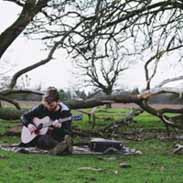Anatomy & Physiology: Chapter 2 & 3 – Flashcards
Unlock all answers in this set
Unlock answersquestion
The number of protons plus the number of neutrons
answer
Atomic weight (mass)
question
A combination of two or more atoms of different elements
answer
Compound
question
A small, negatively charged particle that orbits the nucleus
answer
Electron
question
An atom that has gained or lost electrons, and thus carries an electrical charge
answer
Ion
question
Atoms are held together by sharing electrons
answer
Covalent Bond
question
The most fundamental substances of matter
answer
Elements
question
A substance that combines with hydrogen ions
answer
Base
question
A molecule that influences the rate of chemical reactions but is not consumed in the reaction
answer
Catalyst
question
Two atoms with the same atomic number but different atomic weights
answer
Isotopes
question
A substance that releases ions in water
answer
Electrolyte
question
The number of protons in an atom
answer
Atomic number
question
The area of an atom where protons and neutrons are located
answer
Nucleus
question
Loosely coiled fibers containing protein and DNA within nucleus
answer
Chromatin
question
Location of ATP production for cellular energy
answer
Mitochondrion
question
Small RNA-containing particles for the synthesis of proteins
answer
Ribosome
question
Membranous sac that stores or transports substances
answer
Vesicle
question
Dense body of RNA and protein within the nucleus
answer
Nucleolus
question
Slender tubes that provide movement in cilia and flagella
answer
Microtubule
question
Composed of membrane-bound canals and sacs for tubular transport throughout the cytoplasm
answer
Endoplasmic Reticulum
question
Occupies space between cell membrane and nucleus
answer
Cytoplasm
question
Flattened, membranous sacs that package a secretion
answer
Golgi Apparatus
question
Membranous sac that contains digestive enzymes
answer
Lysosome
question
Separates nuclear contents from cytoplasm
answer
Nuclear envelope
question
Spherical organelle that contains chromatin and nucleolus
answer
Nucleus
question
G1 - Cell grows, S - DNA is duplicated, G2 - cell grows and makes sure all the organelles are duplicated
answer
Interphase
question
Nuclear membrane breaks down; nucleolus disappears; centrioles begin to migrate to opposite sides of the cell; spindle begins to form; homologous chromosomes form; crossing over occurs
answer
Mitosis
question
Homologous chromosomes are lined up down the middle of the cell
answer
Metaphase
question
Homologous chromosomes are pulled apart and sister chromatids are pulled to opposite sides of the cell
answer
Anaphase
question
Nuclear membrane reforms, nucleus reappears; spindle fibers disappear; cell divides in 2
answer
Telophase
question
During anaphase; cell membrane starts to constrict down the middle of the cell and continues through telophase
answer
Cytokinesis
question
During what phase of the cell cycle is DNA replicated?
answer
S-phase
question
How are gametes produced?
answer
Meiosis
question
Is water polar or nonpolar?
answer
Nonpolar
question
Meiosis results in the formation of what?
answer
Egg and sperm cells
question
What are stem cells?
answer
Cells that can divide
question
What are the base pairing rules of DNA?
answer
AG & CT
question
What are the most common elements in living things?
answer
C, N, H, O
question
What are the phases of mitosis?
answer
PMAT - Prophase, Metaphase, Anaphase, Telophase
question
What atoms make up water?
answer
H, O
question
What does isotonic, hypertonic, hypotonic mean? What happens to cells in these states?
answer
Iso - same osmotic pressure, cell has carbon; hyper - high pressure in cell, no change; hypo - lower pressure in cell, cell swells and bursts
question
What does organic mean?
answer
Has carbon
question
What happens to a cell that does not divide?
answer
It dies
question
What is the nucleus of an atom made up of?
answer
nucleoplasm, nucleolus, chromatin
question
What is a compound?
answer
Atoms of different elements bond
question
What is a covalent bond?
answer
Chemical bond formed by electron sharing between atoms
question
What is an isotope?
answer
Has the same number of protons, with a different number of neurons
question
What is cytoplasm?
answer
Contents of a cell, including the nucleus and cell membrane
question
What is denaturation?
answer
Hydrogen bonds in protein break from excessive heat, etc.
question
What is diffusion?
answer
Movement of particles from higher to lower concentrated areas.
question
What is endocytosis? Exocytosis?
answer
Cell membrane envelopes a substance and draws into cell by a vesicle; transports out of cell
question
What is metastasis?
answer
Cancer-spreading process
question
What is osmosis?
answer
Diffusion of water through a selectively permeable membrane in response to a concentration gradient
question
What is the atomic number?
answer
Number of protons in an atom of an element
question
What is the difference between microtubules and microfilaments?
answer
Tubules - Long slender tubes; Filaments - Tiny rods of protein
question
What is the flexible barrier around a cell?
answer
Cell membrane
question
What is the function of a cell's nucleus?
answer
Houses genetic material
question
What is the function of an enzyme?
answer
Protein that catalyzes or speeds chemical reaction
question
What is the function of the cell membrane?
answer
Controls substances that enter and leave the cell
question
What is the function of the cytoskeleton?
answer
Framework/Structure
question
What is the monomer of a carb? Lipid? Nucleic acid? Protein?
answer
Monosaccharides, none, nucleotides, amino acids
question
What is the pH of an acid, of a base?
answer
0-7; 7-14
question
What is the role of spindle fibers during mitosis?
answer
To pull apart centromeres
question
What organelle breaks down food into energy?
answer
Lysosomes
question
What organelle breaks down macromolecules?
answer
Lysosomes
question
What organelle is found in plant cells but not in animal cells?
answer
Chloroplasts
question
What structure carries out cell movement?
answer
Flagella
question
What structure makes proteins?
answer
Ribosomes
question
What structure provides cells with energy?
answer
Mitochondrion
question
What structures are found in cytoplasm?
answer
Mitochondrion, Endoplasmic Reticulum, Golgi Apparatus, Chloroplasts
question
Where is genetic material stored?
answer
Golgi apparatus
question
What organelle breaks down organelles that are no longer useful?
answer
Lysosomes
question
A small, negatively charged particle that orbits the nucleus
answer
Electron



